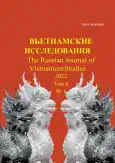Многомерная бедность и человеческое развитие во Вьетнаме и странах Юго-Восточной Азии: сравнительный анализ
- Авторы: Нгуен Д.Т.1
-
Учреждения:
- Вьетнамская академия общественных наук
- Выпуск: Том 6, № 1 (2022)
- Страницы: 40-51
- Раздел: Научные исследования
- URL: https://ogarev-online.ru/2618-9453/article/view/105388
- DOI: https://doi.org/10.54631/VS.2022.61-105388
- ID: 105388
Цитировать
Аннотация
Согласно ежегодным докладам о человеческом развитии, выпускаемым Программой развития ООН (ПРООН), и данным по многомерной бедности в мире, представленным Оксфордской инициативой по борьбе с бедностью и развитию человеческого потенциала (Oxford Poverty and Human Development Initiative, OPHI), Вьетнам в последние годы добился обнадёживающих достижений в человеческом развитии и снижении уровня многомерной бедности. Однако, по сравнению с другими странами региона, принятые меры выглядят недостаточными. Основываясь на данных ПРООН по индексу человеческого развития (ИЧР) и данных OPHI по индексу многомерной бедности (ИМБ), автор предпринимает попытку проанализировать и сопоставить показатели ИМБ и ИЧР Вьетнама с показателями ряда других стран Юго-Восточной Азии, чтобы выявить направления человеческого развития и пути сокращения многомерной бедности во Вьетнаме в последние годы.
Полный текст
Открыть статью на сайте журналаОб авторах
Динь Туан Нгуен
Вьетнамская академия общественных наук
Автор, ответственный за переписку.
Email: tuanihs@yahoo.com
ORCID iD: 0000-0002-2079-6750
к. соц. н. (антропология), старший научный сотрудник, Институт исследований человека
Вьетнам, Ханой, р-н Бадинь, ул.Лиеу Зяй, 1.Список литературы
- Alkire S. & Foster J. Counting and Multidimensional Poverty // Von Braun J. (ed.) The Poorest and Hungry: Assessment, Analysis and Actions. Washington D.C.: International Food Policy Research Institute, 2009.
- Alkire S. & Foster J. Counting and Multidimensional Poverty Measurement // Journal of Public Economics. 2011. No. 95 (7–8). P. 476–487. doi: 10.1016/j.jpubeco.2010.11.006.
- ADB – Asian Development Bank. Basic statistics 2021. URL: https://www.adb.org/publications/basic-statistics-2021 (дата обращения: 19.01.2022).
- Atkinson A.B. & Bourguignon F. The of Comparison of Economic Distributions Multi-Dimensioned Status // The Review of Economic Studies. 1982. No. 49 (2). P. 183–201.
- Chakravarty S.R., D’Ambrosio C. The Measurement of Social Exclusion // Review of Income and Wealth. 2006, Sept. Vol. 52 (3). P. 377–398.
- Dang Nguyen Anh. Multidimensional Poverty in Vietnam: Policies and Reality. 2015. URL: https://vass.gov.vn/noidung/tintuc/Lists/KhoaHocCongNghe/View_Detail.aspx?ItemID=21 (дата обращения: 20.08.2021).
- Dinh Quang Hai. The Rich–Poor Polarisation in Vietnam and its Impacts on Vietnamese Society // Russian Journal of Vietnamese Studies. 2021. No. 1. P. 79–101. doi: 10.24411/2618-9453-2021-10004.
- Foster J.E. & Shorrocks A.F. Poverty Orderings and Welfare Dominance // Social Choice and Welfare. 1988. No. 5 (2–3). P. 179–198. doi: 10.1007/BF00735760.
- Luong Thuy Duong & Vu Quoc Huy. Measuring Multi-Dimensional Poverty for Regions in Vietnam for the Period 2010–2014 // Human Studies. 2017. No. 2 (89). P. 15–30.
- Madan S. Human Development and Poverty –a Perspective Across Indian States. 2012. URL: https://www.czso.cz/documents/10180/20550301/e-180212q4k08.pdf/2ff5cd45-ad59-480f-88bb-b853567a88aa?version=1.0
- Nguyen Dinh Tuan. Some Factors Affect the Poor People’s Opportunity to Access Health Care Services in Our Country Today // Journal of Sociology. № 3 (127). 2014. P. 43–52.
- OPHI – Oxford Poverty and Human Development Initiative. Global MPI data tables 2021. URL: https://ophi.org.uk/multidimensional-poverty-index/data-tables-do-files/ (дата обращения: 10.01.2022).
- OPHI and UNDP – Oxford Poverty and Human Development Initiative and United Nations Development Programme. Global Multidimensional Poverty Index 2021: Unmasking Disparities by Ethnicity, Caste and Gender. URL: https://ophi.org.uk/wp-content/uploads/UNDP_OPHI_GMPI_2021_Report_Unmasking.pdf (дата обращения: 10.01.2022).
- Ray R. & Sinha K. Multidimensional Deprivation in China, India and Vietnam: A Comparative Study on Micro Data // Micro. № 16 (1). 2011. P. 1–38. doi: 10.1080/19452829.2014.897311.
- Sen A. Poverty: An Ordinal Approach to Measurement // Econometrica: Journal of the Econometric Society. 1976. P. 219–231. doi: 10.2307/1912718.
- UNDP – United Nations Development Programme. Human Development Data Center. URL: http://hdr.undp.org/en/data# (дата обращения: 10.01.2022).
- UNDP (2010) – Human Development Report 2010. URL: http://hdr.undp.org/sites/default/files/ reports/270/hdr_2010_en_complete_reprint.pdf
- UNDP (2011) – Human Development Report 2011. Sustainability and Equity: A Better Future for All. URL: https://hdr.undp.org/sites/default/files/reports/271/hdr_2011_en_complete.pdf.
- UNDP 2020 – Human Development Report 2020: The Next Frontier Human Development and the Anthropocene. 2020. URL: http://hdr.undp.org/sites/default/files/hdr2020.pdf
- UNDP and VASS – United Nations Development Programme (UNDP) and Viet Nam Academy of Social Sciences (VASS). Growth That Works for All: Viet Nam Human Development Report 2015 on Inclusive Growth. Ha Noi: Social Sciences Pubishing House, 2015.
- Wang X., Feng H., Xia Q. et al. On the Relationship between Income Poverty and Multidimensional Poverty in China // OPHI working paper. 2016. No. 101. URL: https://www.ophi.org.uk/wp-content/uploads/OPHIWP101_1.pdf
Дополнительные файлы












